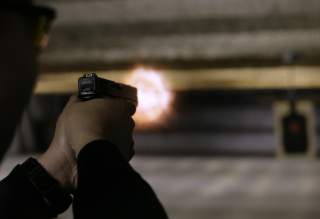Introducing the RIP Bullet: The Most Dangerous Ammo You Can Legally Buy?
The Radically Invasive Projectile is an upgrade for standard handguns designed to make them more lethal without compromising other factors such as magazine capacity.
The RIP bullet is a particularly vicious-looking round. The all-copper bullet is precision machined with multiple grooves, creating a round that ends with nine pointed tips. Upon impact, the bullet breaks apart along the grooves, creating nine different penetrating projectiles.
A new bullet on the market promises increased lethality for handguns, acting like a hole saw against human targets.
(This first appeared last month.)
The Radically Invasive Projectile, or RIP bullet, uses machined copper-tipped bullets to make multiple penetrations into a target, including the main body of the bullet, creating up to nine different wound channels. The RIP bullet is designed to create massive wounding, leading to rapid blood loss and target incapacitation.
The quest for greater lethality in firearms is a never-ending one. Technological innovations in the area of firearm lethality tend to branch into three categories: new calibers, aiming aids, and bullet technology. New handgun and rifle calibers over the past thirty years include .40 Smith & Wesson, 6.5 Creedmoor, .224 Valkyrie and others. Gun accessories that aid in aiming such as tritium iron sights, lasers, and red dot sights are now commonplace on long guns and increasingly handguns. Research into bullet technology has led to the development of hollow point bullets, among others.
In 2014, a company called G2 Research released a new round called the Radically Invasive Projectile, or RIP bullet. The RIP bullet is an Advanced Energy Transfer (AET) or frangible round. AET rounds are intentionally designed to fracture a single round into smaller pieces upon impact. As Globalsecurity.org describes it, “This maximizes the round's transfer of energy to the object and minimizes the chances that pieces of the bullet will exit the object at dangerous velocities. Each of the small fragments quickly loses any energy and therefore pose very little danger to any secondary targets. This means that full-power frangible bullets can be shot at target all the way up to muzzle contact without any worries that the bullet or case will ricochet and potentially hurt either the shooter or others.”
AET rounds were originally developed in the 1970s after a rash of domestic and international airliner hijackings. Security personnel, particularly air marshals, required a round that could deliver devastating energy against a target while not over-penetrating the skin of a commercial airliner and risking explosive decompression. This technology later carried over into the home defense market, as private individuals looked for home defense ammunition that would not penetrate multiple walls or the exterior of a house.
The RIP bullet is a particularly vicious-looking round. The all-copper bullet is precision machined with multiple grooves, creating a round that ends with nine pointed tips. Upon impact, the bullet breaks apart along the grooves, creating nine different penetrating projectiles. The idea is that these nine projectiles, all of which penetrate the human body in a pattern with an overall diameter of three or four inches, have a greater likelihood of contacting an internal organ. Barring that, they would create rapid blood loss. Either would have a higher probability of incapacitating the target than a single large bullet.
One of the first RIP bullets was the nine millimeter Luger round. The RIP nine millimeter round promises to deliver no less than nine wound channels with an overall diameter of three to four inches. Furthermore, the round penetrated to only fourteen to sixteen inches. Most human targets are assumed to be approximately twelve inches wide at the torso, plus an extra inch or three of clothing depending on the weather. If the round does pass through a human torso, it has little energy to continue to pass through walls and other barriers to pose a danger to innocents. This amount of penetration also means the RIP bullet has the ability to initially penetrate “sheet metal, sheet rock, windshields, plywood, (and) heavy winter clothing” and still have enough energy to enter a human body and make contact with internal organs.
The RIP bullet is a 92-grain bullet with a muzzle velocity of 1,250 feet per second and a muzzle energy of 319 foot-pounds. By comparison, a typical 124 grain nine millimeter Luger round has a muzzle velocity of 1,120 feet per second and 345 foot-pounds of energy at the muzzle. Independent testing (with ammunition provided by the manufacturer) appears to confirm the company’s claims regarding penetration, wounding diameter, and the number of wound channels. The company has since released a wide variety of handgun rounds, from .380 Auto to .45 ACP.
The Radically Invasive Projectile is an upgrade for standard handguns designed to make them more lethal without compromising other factors such as magazine capacity. The rounds frangible qualities make it dangerous to targets while decreasing the likelihood of the bullet striking innocents. A bullet like the RIP could be an ideal round for home and business owners looking for a powerful, effective self-defense round.
Kyle Mizokami is a defense and national security writer based in San Francisco who has appeared in the Diplomat, Foreign Policy, War is Boring and the Daily Beast. In 2009 he cofounded the defense and security blog Japan Security Watch. You can follow him on Twitter: @KyleMizokami.


